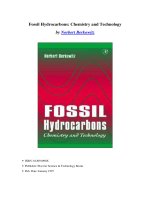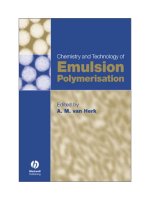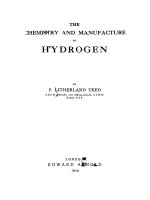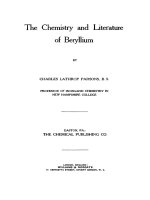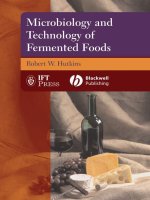chemistry and technology of emulsion polymerisation, 1405121
Bạn đang xem bản rút gọn của tài liệu. Xem và tải ngay bản đầy đủ của tài liệu tại đây (2.99 MB, 324 trang )
Chemistry and Technology of Emulsion
Polymerisation
Chemistry and Technology of
Emulsion Polymerisation
Edited by
A. van Herk
Head of Emulsion Polymerisation Group
Eindhoven University of Technology
Netherlands
Blackwell
Publishing
© 2005 Blackwell Publishing Ltd
Editorial Offices:
Blackwell Publishing Ltd, 9600 Garsington Road, Oxford OX4 2DQ, UK
Te l: +44 (0)1865 776868
Blackwell Publishing Professional, 2121 State Avenue, Ames, Iowa 50014-8300, USA
Te l: +1 515 292 0140
Blackwell Publishing Asia, 550 Swanston Street, Carlton, Victoria 3053, Australia
Te l: +61 (0)3 8359 1011
The right of the Authors to be identified as the Authors of this Work has been asserted in accordance with the
Copyright, Designs and Patents Act 1988.
All rights reserved. No part of this publication may be reproduced, stored in a retrieval system, or transmitted,
in any form or by any means, electronic, mechanical, photocopying, recording or otherwise, except as
permitted by the UK Copyright, Designs and Patents Act 1988, without the prior permission of the publisher.
First published 2005 by Blackwell Publishing Ltd
Library of Congress Cataloging-in-Publication Data
Herk, Alex van.
Chemistry and Technology of Emulsion Polymerisation/Professor van Herk – 1st ed.
p. cm.
Includes bibliographical references and index.
ISBN-13: 978-1-4051-2113-2 (hardback: acid-free paper)
ISBN-10: 1-4051-2113-0 (hardback: acid-free paper)
1. Emulsion polymerisation. 2. Latex – Industrial applications. I. Title.
QD382.E48.H47 2005
668.9–dc22 2005001441
ISBN 10: 1-4051-2113-0
ISBN 13: 978-1-4051-2113-2
A catalogue record for this title is available from the British Library
Set in 10/12 pt Minion
by Newgen Imaging Systems (P) Ltd., Chennai, India
Printed and bound in India
by Replika Press Pvt Ltd
The publisher’s policy is to use permanent paper from mills that operate a sustainable forestry policy, and
which has been manufactured from pulp processed using acid-free and elementary chlorine-free practices.
Furthermore, the publisher ensures that the text paper and cover board used have met acceptable
environmental accreditation standards.
For further information on Blackwell Publishing, visit our website:
www.blackwellpublishing.com
Cover image provided with kind permission of H. Hassander,
Lund University, Lund, Sweden
Contents
Contributors x
List of Frequently Used Symbols xii
Abbreviations xiv
Introduction 1
1 Historic Overview
Finn Knut Hansen 3
1.1 The early stages 3
1.2 The second half of the twentieth century 11
1.2.1 Product de velopment 11
1.2.2 Kinetic theory 14
1.2.3 Emulsion polymerisation in monomer droplets 22
1.2.4 Industrial process control and simulation 23
2 Introduction to Radical (co)Poly merisation
Alex van Herk 25
2.1 Mechanism of free ra dical polymerisation 25
2.2 Rate of polymerisation and development of molecular mass distribution 27
2.2.1 Rate of polymerisation 27
2.2.2 Kinetic chain length 28
2.2.3 Chain length distribution 30
2.2.4 Temperature and conversion effects 32
2.3 Radical transfer reactions 34
2.3.1 Radical transfer reactions to low molecular mass species 34
2.3.2 Radical transfer reactions to polymer 35
2.4 Radical copolymer isation 38
2.4.1 Derivation of the copolymerisation equation 38
2.4.2 Types of copolymers 40
2.4.3 Polymerisation rates in copolymerisations 43
2.5 Controlled radical polymerisation 44
vi Contents
3 Emulsion Polymerisation
Alex van Herk and Bob Gilbert 46
3.1 Introduction 46
3.2 General aspects of emulsion polymerisation 47
3.3 Basic principles of emulsion polymerisation 48
3.4 Particle nucleation 49
3.4.1 Nucleation when micelles are present 51
3.4.2 Homogeneous nucleation 53
3.5 Particle growth 54
3.5.1 The zero-one and pseudo-bulk dichotomy 54
3.5.2 Zero-one kinetics 56
3.5.3 Pseudo-bulk kinetics 58
3.5.4 Systems between zero-one and pseudo-bulk 59
3.6 Ingredients in recipes 60
3.6.1 Monomers 60
3.6.2 Initiators 61
3.6.3 Surfactants 61
3.6.4 Other ingredients 62
3.7 Emulsion copolymerisation 62
3.7.1 Monomer partitioning in emulsion polymerisation 62
3.7.2 Composition drift in emulsion co- and terpolymerisation 65
3.7.3 Process strategies in emulsion copolymerisation 68
3.8 Particle morphologies 70
3.8.1 Core–shell morphologies 72
3.8.2 Organic cores 72
3.8.3 Encapsulation of inorganic particles 73
3.8.4 Hollow particles 74
3.8.5 Reactive latexes 75
4 Emulsion Copolymerisation: Process Str ategies and Morphology
Jose Ramon Leiza and Jan Meuldijk 79
4.1 Introduction 79
4.2 Monomer partitioning 83
4.2.1 Slightly and partially water-miscible monomers 83
4.2.2 Consequences of monomer partitioning for the copolymer
composition 88
4.3 Process strategies 90
4.3.1 Batch operation 90
4.3.2 Semi-batch operation 93
4.3.3 Control opportunities 96
4.3.4 Particle morphology 108
5 Living Radical Polymerisation in Emulsion and Miniemulsion
Michael J. Monteiro and Bernadette Charleux 111
5.1 Introduction 111
5.2 Living radical polymerisation 112
5.2.1 General features of a controlled/living polymerisation 112
Contents vii
5.2.2 Reversible termination 114
5.2.3 Reversible chain transfer 119
5.3 NMP in emulsion and miniemulsion 123
5.3.1 Introduction 123
5.3.2 Control of molar mass and MMD 124
5.3.3 Synthesis of block and gradient copolymers 129
5.4 ATRP in emulsion and miniemulsion 130
5.4.1 Introduction 130
5.4.2 Direct ATRP 130
5.4.3 Reverse ATRP 131
5.4.4 ATRP with simultaneous reverse and normal initiation 133
5.5 Reversible chain transfer in emulsion and miniemulsion 133
5.5.1 Low C
ex
RCTAs 134
5.5.2 High C
ex
RCTAs 135
5.6 Conclusion 139
6 Colloidal Aspects of Emulsion Polymerisation
Brian Vincent 140
6.1 Introduction 140
6.2 The stabilisation of colloidal particles against aggregation 141
6.3 Pair-potentials in colloidal dispersions 143
6.3.1 Core–core interactions 143
6.3.2 Structural interactions 144
6.4 Weak flocculation and phase separation in particulate
dispersions 152
6.5 Aggregate structure and strength 156
7 Analysis of Polymer Molecules: Reaction Monitoring and Control
Peter Schoenmakers 160
7.1 Sampling and sample handling 160
7.1.1 Sampling 160
7.1.2 Sample preparation 160
7.2 Monomer conversion 161
7.3 Molar mass 163
7.3.1 Molar-mass distributions 164
7.4 Chemical composition 170
7.4.1 Average chemical composition 170
7.4.2 Molar-mass dependent chemical composition 171
7.4.3 Chemical-composition distributions 174
7.4.4 Two-dimensional distributions 179
7.5 Detailed molecular characterization 183
7.5.1 Chain regularity 183
7.5.2 Branching 185
viii Contents
8 Particle Analysis: Particle Size, Particle Shape and Structure and Surface
Characterisation
Ola J. Karlsson and Brigitte E.H. Schade 186
8.1 Introduction 186
8.2 Particle size and particle size distribution 186
8.2.1 Introduction 186
8.2.2 Average particle diameter 187
8.2.3 Particle size distribution 188
8.3 Sampling 189
8.4 Particle size measurement methods 189
8.4.1 Ensemble techniques 190
8.4.2 Particle separation methods 198
8.5 Comparison of methods 207
8.5.1 Choice of a method 209
8.6 Particle shape, structure and surface characterization 210
8.6.1 Introduction to particle shape, structure and
surface characterization 210
8.6.2 Classification of the samples 212
8.6.3 General considerations – sample preparation if the latex is
film forming 212
9 Large-Volume Applications of Latex Polymers
Dieter Urban, Bernhard Schuler and Jürgen Schmidt-Thümmes 226
9.1 Market and manufacturing process 226
9.1.1 History and market today 226
9.1.2 Manufacturing process 227
9.2 Paper and paperboard 227
9.2.1 The paper manufacturing process 227
9.2.2 Surface sizing 228
9.2.3 Paper coating 229
9.3 Paints and coatings 235
9.3.1 Technology trends 236
9.3.2 Raw materials for water-borne coating formulations 237
9.3.3 Decorative coatings 242
9.3.4 Protective and industrial coatings 244
9.4 Adhesives 244
9.4.1 Design of emulsion polymer adhesives 245
9.4.2 Formulation additives 249
9.4.3 Adhesive applications 251
9.4.4 Adhesive test methods 252
9.5 Carpet backing 254
9.5.1 Carpet backing binders 254
9.5.2 Carpet backing compounds 255
9.5.3 Application requirements 255
Acknowledgments 256
Contents ix
10 Specialty Applications of Latex Polymers
Christian Pichot and Thier ry Delair 257
10.1 Introduction 257
10.2 Specific requirements for the design of speciality latex particles 257
10.2.1 Nature of polymer 258
10.2.2 Particle size and size distribution 259
10.2.3 Particle morphology 259
10.2.4 Nature of interface 259
10.2.5 Surface potential 260
10.2.6 Colloidal stability 260
10.2.7 Functionality 261
10.3 Preparation methods of latex particles for specialty applications 262
10.3.1 Radical-initiated polymerization in heterogeneous media 262
10.3.2 Formulation of colloidal dispersions from preformed polymers 266
10.4 Applications 268
10.4.1 Non-biomedical applications 268
10.4.2 Biological, biomedical and pharmaceutical applications 272
10.5 Conclusions 277
References 279
Index 299
Contributors
Prof. Dr Bernadette Charleux Université Pierre et Marie Curie, Laboratoire de Chimie
des Polymères, Tour 44 Couloir 44-54 ler Etage,
4 place Jussieu F-75252 Paris Cedex 05, France
Dr Thierry Delair Unité Mixte CNRS/bioMérieux ENS,
Lyon, 46 Allée d’Italie, Lyon Cedex 07 69364, France
Prof. Bob Gilbert University of Sydney, Key Centre for
Polymer Colloids, Chemistry School F11,
Sydney NSW 2006, Australia
Prof. Dr Finn Knut Hansen University of Oslo, Department of Chemistry,
P.O. Box 1033, Blindern 0315 Oslo, Norway
Dr Ola Karlsson Lund University, Department of Physical Chemistry
P.O. Box 124, Lund SE-221 00, Sweden
Dr Jose Ramon Leiza Euskal Herriko Unibertsitatea, Polymat/Kimika
Aplikatun Departamentua Kimika Fakultatea,
M. Lardizabal, 3, 20018 Donostia, Spain
Dr Jan Meuldijk Eindhoven University of Technology, HEW 0.39,
P.O. Box 513, 5600 MB Eindhoven, The Netherlands
Dr Michael J. Monteiro University of Quensland, Australian Institute of
Bioengineering and Nanotechnology, Department of
Chemistry, Brisbane, QLD 4072, Australia
Dr Christian Pichot Unité Mixte CNRS/bioMérieux ENS,
Lyon, 46 Allée d’Italie, Lyon Cedex 07 69364, France
Ing. Brigitte E.H. Schade Particle Sizing Systems, Waterman 182, 3328 RK
Dordrecht, Holland
Dr Jürgen Schmidt-Thümmes BASF AG, Polymer Research, GKD-B1,
D-67056 Ludwigshafen, Germany
Prof. Peter Schoenmakers University of Amsterdam, Polymer-Analysis
Group, Department of Chemical Engineering,
Nieuwe Achtergracht 166, 1018 WV Amsterdam,
The Netherlands
Contributors xi
Dr Bernhard Schuler BASF AG, Polymer Research, GKD-B1,
D-67056 Ludwigshafen, Germany
Dr Dieter Urban BASF AG, Polymer Research, GKD-B1,
D-67056 Ludwigshafen, Germany
Prof.DrAlexvanHerk Eindhoven University of Technology, Department of
Polymer Chemistry, P.O. Box 513,
5600 MB Eindhoven, The Netherlands
Prof. Brian Vincent University of Bristol, School of Chemistry, Cantock’s
Close, Bristol, BS8 1TS
List of Frequently Used Symbols
a
e
specific surface area for a emulsifier molecule on a polymeric surface
A Arrhenius constant of the initiation (A
i
), propagation (A
p
), termination (A
t
)
and transfer (A
tr
)
d average particle diameter, d
n
number average diameter, d
s
surface average
diameter, d
w
weight average diameter, d
v
volume average diameter
d
w
/d
n
particle diameter non-unifor mity factor
E energy of activation for initiation (E
i
), propagation (E
p
), termination (E
t
)
and transfer (E
tr
)
f initiator efficiency
F efficiency factor for adsorption
G partial molar free energy of droplets G
d
, G
a
of the aqueous phase and of
the latex particles G
p
H enthalpy
H change in enthalpy
j
crit
critical length of an oligomer at which precipitation from the aqueous phase
occurs
k exit frequency
k rate constant of the initiation (k
i
), propagation (k
p
), termination (k
t
) and
transfer reaction (k
tr
)
[M] concentration of monomer, [M]
p
concentration of monomer in the
polymer particles. If this depends on quantities such as radius r, time t etc.,
the notation is [M(r, t, )]
p
. [M]
a
for the monomer concentration in the
aqueous phase, [M]
a,sat
for the saturation concentration in the aqueous
phase
M average molar mass: number-average molar mass (M
n
); weight-average
molar mass (M
w
)
N number of latex particles per unit volume of latex
N
n
number of particles with n radicals per particle
N
A
Avogadro constant
n number of radicals in a latex particle
n average number of radicals per particle
n
m0
initially added number of moles of monomer per unit volume
P
n
number average degree of polymerisation
R gas constant
List of Frequently Used Symbols xiii
r
1,2
reactivity parameters in copolymerisation
r
p
rate of polymerisation per particle
r
e
rate of entry of radicals per particle
r
t
rate of termination per particle
r
0
the radius of the unswollen micelles, vesicles and/or latex particles
R
p
rate of polymerisation
S entropy
S change in entropy
T temperature
T
g
glass transition temperature
t time
V volume of monomer swollen latex particles
V
m
molar volume of the monomer
v
p
volume fraction of polymer (also φ
p
)
W stability ratio
w
p
mass fraction of polymer in the particle phase
X fraction conversion of monomer to polymer
X
n
number-average degree of polymerisation, X
w
weight-average degree of
polymerisation
z-mer the length of an oligomer in the aqueous phase at which surface activity
occurs
α fate parameter (fate of excited radicals)
χ Flory–Huggins interaction parameter
δ solubility parameter or chemical shift
ε permittivity
γ interfacial tension
η v iscosity
[η] intrinsic viscosity
ν kinetic chain length
π osmotic pressure
ρ entry frequency
ρ
i
radical flux or rate of initiation (2k
d
f [I])
μ volume growth factor
τ
g
time of growth of a polymer chain
φ
p
volume fraction of polymer
Abbreviations
AA Acrylic acid
ABS Acrylonitrile–butadiene–styrene
Aerosol MA AMA, sodium di-hexyl sulphosuccinate
Aerosol OT AOT, sodium di(2-ethylhexyl)sulphosuccinate
AFM Atomic force microscopy
AIBN Azobisisobutyronitrile
APCI Atmospheric-pressure chemical ionisation
ATR Attenuated total reflectance
ATRP Atom transfer radical polymerisation
B Butadiene
BA n-Butyl acrylate
BPO Benzoyl peroxide
BSE Backscatter electrons
Buna N Butadiene–acrylonitrile copolymer
Buna S Butadiene–styrene copolymer
CCA Colloidal crystalline array
CCD Chemical composition distribution
CDB Cumyl dithiobenzoate
CFM Chemical force microscopy
CFT Critical flocculation temperature
CHDF Capillary hydrodynamic fractionation
CMC Critical micelle concentration
CMMD Control molar mass distribution
CPVC Critical pigment volume concentration
CRP Controlled radical polymerisation
CTA Chain transfer agent
CVP Colloid vibration potential
Cyclam Tetrazacyclotetradecane
DLS Dynamic light scattering
DLVO Derjaguin–Landau–Verwey–Overbeek
DMA Dynamic mechanical analysis
DNA Desoxy nucleic acid
DSC Differential scanning calorimetry
EDTA Ethylene diamino tetraacetic acid
Abbreviations xv
EHMA 2-Ethylhexyl methacrylate
EPA Environmental Protection Agency
ES Electrozone sensing
ESA Electrokinetic sonic amplitude
ESD Equivalent spherical diameter
ESEM Environmental scanning electron microscopy
ESI Electrospray ionisation
FESEM Field emission scanning electron microscopy
FFF Field-flow fractionation
FLGN Feeney, Lichti, Gilbert and Napper
FTD Functionality-type distribution
FTIR Fourier-transform infrared
GC Gas chromatography
GPC Gel permeation chromatography
HASE Hydrophobically modified alkali-swellable emulsions
HDC Hydrodynamic chromatography
HDPE High density polyethylene
HEC Hydroxylethyl cellulose
HEMA 2-Hydroxyethyl methacrylate
HEUR Hydrophobically modified ethylene oxide urethanes
HOST Homogeneous start
HIC Hydrophobic interaction chromatography
HPLC High performance liquid chromatography
HUFT Hansen, Ugelstad, Fitch and Tsai
i-LC Interactive liquid chromatography
IR Infrared
IVC Intrinsic-viscosity distribution
KKelvin
LC Liquid chromatography
LD Laser diffraction
LE Light extinction
LIST Line start
LRP Living radical polymerisation
LS Light scattering
MA Methyl acrylate
MALDI Matrix-assisted laser desorption/ionisation
MFFT Minimum film forming temperature
MMA Methyl methacrylate
MMD Molar mass distribution
MONAMS A5 1-(methoxycarbonyl)eth-1-yl initiating radical
MS Mass spectrometry
NIR Near-infrared
NMP Nitroxide-mediated living radical polymerisation
NMR Nuclear magnetic resonance
NR Natural rubber
xvi Abbreviations
OM Optical microscopy
PCH Phenyl-cyclohexene
PCS Photon correlation spectroscopy
PDI Polydispersity index
PDMS Poly(dimethylsiloxane)
PE Polyethylene
PEO Poly(ethylene oxide)
PGA Poly(g lycolic acid)
PHD Pulse height distribution
PHS Poly(hydroxystearic acid)
PLA Poly(d, l-lactic acid)
PLP Pulsed-laser polymerisation
PLGA Poly(glycolic–co–lactic acid)
PMMA Poly(methyl methacrylate)
PNIPAM Poly(N-isopropylacrylamide)
PPO Polypropylene oxide
PRE Persistent radical effect
PS Polystyrene
PSA Pressure-sensitive adhesives
PSD Particle size distribution
PTA Phosphotungstic acid
PTFE Poly tetrafluorethylene
PTV Programmed temperature vaporiser
PVAc Poly(vinyl acetate)
PVC Pigment volume concentration
QELS Quasi-elastic light scatter ing
RAFT Reversible addition fragmentation transfer
RCTA Reversible chain transfer agents
RI detector Refractive-index detector
SStyrene
SAM Self-assembled monolayer
SANS Small angle neutron scattering
SAXS Small angle X-ray scattering
SB Styrene–butadiene
SBLC Styrene Butadiene Latex Council
SBR Styrene–butadiene rubber
SDS Sodium dodecyl sulphate
Sed-FFF Sedimentation field-flow fractionation
SEC Size exclusion chromatography
SEM Scanning electron microscopy
SFM Scanning force microscopy
SPM Scanning probe microscopy
SPOS Single-particle optical sensing
SRNI Simultaneous reverse and normal initiation
SSIMS Static secondary ion mass spectrometry
STM Scanning tunnelling microscopy
Abbreviations xvii
TEM Transmission electron microscopy
TEMPO 2,2,6,6-Tetramethylpiperidine-l-oxyl
Texanol® 2,2,4-Tr imethyl-1,3-pentanediol-diisobutyrate
TGIC Temperature-gradient interaction chromatography
THF Tetrahydrofaran
TOF Time-of-flight
TREF Temperature-rising elution fractionation
UAc Uranyl acetate
UV Ultraviolet
VAc Vinyl acetate
VCH Vinyl-cyclohexene
VOC Volatile organic compound
W Watt
XPS X-ray photoelectron spectroscopy
XSB Carboxylated styrene-butadiene dispersions
Introduction
The increasing need for environmentally benign production methods for polymers has
resulted in a further development and implementation of the emulsion polymerisation tech-
nique. More and more companies switch from solvent-based polymer production methods
to emulsion polymerisation. New polymerisation mechanisms, such as controlled radical
polymerisation, are combined with the emulsion polymerisation technique, encounter-
ing specific problems but also leading to interesting new possibilities in achieving special
nanoscale morphologies with special properties. In the past years many people have been
trained in the use of the emulsion polymerisation technique. Many courses on the BSc, MSc
and the Ph.D. level as well as special training for people in the indust ry are given all over
the world. Despite this, no recent book exists w ith the purpose of supporting courses in
emulsion polymerisation.
This book is aimed at MSc students, Ph.D. students and reasonably experienced chemists
in university, government or industrial laboratories, but not necessarily experts in emulsion
polymerisation or the properties and applications of emulsion poly mers. For this audience,
which is often struggling with the theory of emulsion polymerisation kinetics, this book
will explain how theory came about from well-designed experiments, making equations
plausible and intuitive. Another issue experienced, especially in the industry, is that coupling
theory and everyday practice in latex production is really hard. This is another aim of the
book; showing how theory works out in real life.
The basis for the contents of this book can be found in the course, ‘Emulsion Polymer-
isation’, taught for many years at the Eindhoven University of Technology in the framework
of the Foundation for Emulsion Polymerisation. In the last 10 years many people have
contributed to shaping the afore-mentioned course and therefore laying a basis for this
book: Ian Maxwell, Jenci Kurja, Janet Eleveld, Joop Ammerdorffer, Annemieke Aerdts, Bert
Klumperman, Jos van der Loos and last but not the least Ton Ger man. Most of the contrib-
utors to the chapters are members of the International Polymer Colloids Group, a group
of experts around the world that meet on a regular basis and form a unique platform for
sharing knowledge in the field.
The book is focusing on emulsion polymerisation in combination with both conven-
tional and controlled radical polymerisation. Except for miniemulsion polymerisation,
more exotic techniques, such as inverse emulsion polymerisation, microemulsion polymer-
isation and dispersion polymerisation are not covered. Chapter 1 gives a historic overview
of the understanding of emulsion polymerisation, while also focusing on the solution of the
Chemistry and Technology of Emulsion Polymerisation
Edited by A. van Herk
Copyright © 2005 Blackwell Publishing Ltd
2 Chemistry and Technology of Emulsion Polymerisation
kinetic equations. In Chapter 2 an introduction is given in the radical (co)polymerisation
mechanism, explaining kinetics and the development of molecular weight and chemical
composition. In Chapter 3, the basic elements of emulsion polymerisation are explained,
again focusing on rate of reaction and molecular mass distributions. In Chapter 4, emul-
sion copolymerisation, process strategies and development of morphology is explained. In
Chapter 5, the implementation of controlled radical polymerisation mechanisms in emul-
sion polymerisation is discussed. Colloidal aspects of emulsion polymerisation are discussed
in Chapter 6. In Chapter 7, an overview of the molecular characterisation techniques of
(emulsion) polymers is given whereas in Chapter 8 the characterisation techniques avail-
able for particle size, shape and morphology are reviewed. In Chapters 9 and 10, bulk and
specialty applications are discussed.
We hope that this book will become a standard textbook in courses in emulsion
polymerisation.
Chapter 1
Historic Overview
Finn Knut Hansen
1.1 The early stages
Polymers are composed of very large molecules, each of which includes a large number of
repeating structural units. The oldest and most abundant group of polymers consists of
natural polymers, such as cellulose, proteins, rubbers etc. Of these, natural rubber occurs in
the form of a latex that is defined as a ‘viscid, milky juice secreted by the laticiferous vessels
of several see-bearing plants, notably Castillia elastica’etc.(Boveyet al., 1955). By far the
most important natural latex is that obtained from the rubber tree Hevea brasiliensis. This
tree, originally from Brazil – as may be deduced from its name – was transplanted to Malaya,
Sri Lanka and the East Indies (Hauser, 1930) in 1876, and e ventually has made these areas
the most important sources of natural rubber. The latex that is obtained from this tree is
usually called ‘natural latex’ and is a colloidal suspension of rubber particles stabilised by
protein. The rubber content of the latex is between 32% and 38% by weight, the protein
1–2%, different natural sugars about 2% and inorganic salts about 0.5% (Hauser, 1930).
The rubber particles vary largely in size from quite small, c.50 nm, up to 1–2 μm. The
rubber latex is coagulated, washed and worked into sheets that form the basis for further
industrial use.
In view of the latex origin of natural rubber, i t was not surprising that when the need
for a synthetic equivalent arose, the mimicking of natural rubber latex was an obvious
starting point. The effort, and great success, of making synthetic rubber by emulsion
polymerisation has eventually resulted in the word‘latex’being also used to refer to colloidal
suspension of synthetic polymers, as prepared by emulsion or suspension polymerisation.
Such synthetic latexes are to be distinguished from dispersion of polymers prepared by
grinding the polymer with water and a dispersing agent. This chapter will treat the early
stages of the ‘invention’ and production of synthetic latexes by emulsion polymerisation
from the beginning and up to the middle of the twentieth century. Several reviews and
books have been written on the early developments in emulsion polymerisation, and have
been a natural starting point for this text. One of the first reviews is that of Hohenstein and
Mark (1946). The following is a direct quotation from their work (reprinted from Journal
of Polymer Science, by permission):
The earliest observations on polymerisation of olefins and diolefins as far back as
1838 (Mark and Rafft, 1941, Regnault, 1838) refer almost entirely to the pure liquid
phase and describe the gradual transition from a liquid monomer to a viscous or solid
Chemistry and Technology of Emulsion Polymerisation
Edited by A. van Herk
Copyright © 2005 Blackwell Publishing Ltd
4 Chemistry and Technology of Emulsion Polymerisation
polymer under the influence of heat, light, or a catalytically active substance. The idea
of using a finely divided monomer in an aqueous suspension or emulsion seems to have
been first conceived, about 1910, by Hofman and Delbrück (Hofman and Delbrück,
1909, 1912) and Gottlob (Gottlob, 1913). There were two main reasons for the desire
to carry out the polymerisation of various simple dienes in the presence of a diluting
agent: one, the fact that the use of metallic sodium as catalyst, which was common
practice at that time, led to highly heterogeneous materials and posed a rather difficult
problem regarding the complete removal of the alkali metal from the final polymer. The
more important incentive for the use of an aqueous system, however, were the facts that
all native rubbers occur in the form of latexes and that, obviously, polymerisation in the
plant takes place under mild conditions in an aqueous phase without the application
of elevated temperatures and high pressures, and certainly without the use of such
catalysts as metallic sodium or alkali alkyls.
The aim of reproducing the physiological conditions occurring in the plant is
mentioned in some of the earlier disclosures (Gottlob, 1913, Hofman and Delbrück,
1909, 1912), and led to the preparation and stabilization of the ‘emulsions’ as described
in these patents not with the aid of soap or other surface-active agents, but by appli-
cation of hydrophilic protective colloids such as gelatin, egg albumin, starch, milk,
and blood serum. Certain remarks in the text of these patents indicate that these
protective colloids not only emulsify the hydrocarbon monomer but may also act as
catalysts during the polymerisation. We have carried out a number of polymerisations,
following closely the methods given as examples in two of these patents and have sub-
stantially confirmed the results of the claims. In these experiments we observed a very
slow, par tial conversion of the monomer (isoprene, dimethylbutadiene) into a poly-
mer latex. The total amount of polymer formed varied between 40% and 80%; the
duration of the reaction was in certain cases as much as six weeks. The results, in
general very erratic and almost irreproducible, create the impression that the reaction
under such conditions could be considered a suspension polymerisation catalyzed by
the oxygen of the air, which was never specifically excluded in any of the examples.
In order to check this conclusion we repeated a few experiments of this type with
deaerated monomer and deaerated water under nitrogen and found that under these
conditions only extremely slow polymerisation can be observed. In some instances
conversion was not achieved at all.
It seems, therefore, that the early practice, as disclosed in the above-mentioned
patents, is substantially different from what is known today as emulsion polymerisa-
tion, and is essentially a suspension polymerisation in which the protective colloids
act as suspension stabilizers and which is catalyzed by the presence of small amounts
of oxygen.
In 1915 and 1916, Ostromislensky (Ostromislensky, 1915, Ostromislensky, 1916,
Talalay and Magat, 1945) carried out similar experiments with vinyl halides and dis-
cussed the advantages of the presence of an inert diluent. However, since there is
no mention of the use of soap or other micelle-forming substances in his articles
either, it seems that his observations also refer to ‘uncatalyzed’ or photocatalyzed
polymerisation in solution and suspension.
It was only in 1927 that the use of soap and similar substances (ammonium, sodium,
and potassium oleates, sodium butylnaphthalene sulphonate) was disclosed in patents
Historic Overview 5
by Dinsmore (Dinsmore, 1927) and Luther and Heuck (Luther and Heuck, 1927).
The examples cited in these disclosures approach present practice to a consider-
able degree; they specify the simultaneous use of emulsifiers and catalyst (water- or
monomer-soluble peroxides) and describe conversions and reaction times of the same
order of magnitude as reported i n more recent scientific articles. It seems, therefore,
that the use of catalyzed emulsion polymerisation is about twenty years old [in 1946,
Ed. note].
In the years following a large number of additional patents accumulated, with an
almost confusing multitude of disclosures and claims (compare references (Hoseh,
1940 and 1941, Scheiber, 1943, Talalay and Magat, 1945)). On the other hand, dur-
ing this same period (1930–1940) only very few articles were published in scientific
journals. Dogadkin (1936) and his collaborators (Balandina et al., 1936b, Balandina
et al., 1936a, Berezan et al., 1936) studied the polymerisation of butadiene in the
presence of soap, peroxides, and other catalysts at different temperatures and invest-
igated the kinetics of this reaction. Fikentscher (Fikentscher, 1934), at a meeting of
the Verein Deutscher Chemiker in 1938, gave a general description of the course of
emulsion polymerisation of dienes and advanced, for the first time, the hypothesis
that polymerisation takes place essentially in the aqueous phase and not inside the
monomer droplets. In 1939, Gee, Davies, and Melville (Gee et al., 1939) investigated
the polymerisation of butadiene vapour on the surface of water containing a small
amount of hydrogen peroxide and came to certain conclusions about the kinetics of
this process. While the mechanism of emulsion polymerisation was thus only infre-
quently and briefly discussed in the scientific literature between 1930 and 1940, much
work was carried out during this same period in the research departments of various
industrial organizations, as shown by the large number of patents filed and issued in
many countries.
One of the authors (H. M.) had an opportunity to discuss the problem of emulsion
polymerisation in the period between 1935 and 1938 with Drs. Fikentscher, H. Hopff,
and E. Valko in Ludwigshafen am Rhine. At that time they offered several arguments
in favour of polymerisation taking place preponderantly in the aqueous phase. Valko
even considered it as highly probable that the monomer, solubilised in the micelles
of the soap solution, was most favourably exposed to the action of a water-soluble
catalyst and, therefore, might be considered as the principal site of the reaction. At a
seminar on high polymers in Kansas City in September 1945, Dr. F. C. Fryling told us
that he had, at the same time, independently arrived at very similar conclusions on
the basis of his own observations. It appears, therefore, that some of the more recent
developments were anticipated to a cer tain extent in the unpublished work between
1930 and 1940.
No work in emulsion polymerisation was published in the next 3 years, except
for brief references in the books of Mark and Rafft (Mark and Rafft, 1941) and of
Scheiber (Scheiber, 1943). In 1941, Fryling (Fryling, 1944) described a very useful
method for carrying out emulsion polymerisation experiments in 10-gram systems
and, together with Harrington (Fryling and Harrington, 1944), investigated the pH
of mixtures of aqueous soap solutions and substituted ethylenes, such as acrylonitrile,
styrene, etc.; they concluded that the monomer which was solubilized in the McBain
layer micelles (McBain, 1942, McBain and Soldate, 1944) was very likely to be the most
6 Chemistry and Technology of Emulsion Polymerisation
important site for initiation of polymerisation. Hohenstein, Mark, Siggia, andVingiello
(Hohenstein, 1945, Hohenstein et al., 1944a, Hohenstein et al., 1944b) studied the
polymerisation of styrene in aqueous solutions without soap and in aqueous emulsions
in the presence of soap. At the New York meeting of the American Chemical Society
in September 1944, Vinograd delivered three excellent lectures ( Vinograd et al., 1944)
on the polymerisation of styrene in aqueous suspension and emulsion. At the same
meeting, Frilette (Frilette, 1944) reported on experiments on the polymerisation of
styrene in very dilute aqueous systems.
In 1945, Hohenstein, Siggia, and Mark (Siggia et al., 1945) published an article
on the polymerisation of styrene in agitated soap emulsions, and Huges, Sawyer and
Vinograd (Huges et al., 1945), Harkins (Harkins, 1945), and Harkins with a number of
collaborators (Harkins et al., 1945) contributed very valuable x-ray data on the McBain
micelles (McBain, 1942) before, dur ing, and after polymerisation. In the same year, two
very interesting articles appeared, by Kolthoff and Dale (Kolthoff and Dale, 1945) and
Price and Adams (Price and Adams, 1945), on the influence of catalyst concentration
on the initial rate of poly merisation; and Montroll (Montroll, 1945) de veloped a
general phenomenological theory of processes during which diffusion and chemical
reaction cooperate in the formation of large molecules.
A large amount of basic research was carried out on all phases of emulsion polymer-
isation as part of the government rubber program, most of which has not yet [1946,
Ed. note] been released for publication. [The paper of Kolthoff and Dale (Kolthoff
and Dale, 1945) was part of this program and was published with the permission of
the Rubber Reserve Company, Washington, D. C.] One can, therefore, look forward in
the not too distant future to many informative articles in this field.
As far as our present knowledge goes, it seems appropriate to distinguish between
the following three types of v i nyl polymerisation of diluted monomers:
(1) Polymerisation in homogeneous solution in which the monomer, all species of
the polymer molecules, and the initiator (catalyst) are soluble in the diluting liquid
(e.g., styrene polymerisation in toluene with benzoyl peroxide). If the solution is suf-
ficiently dilute, such a process begins and ends in a completely homogeneous system
with a dilute molecular solution of the monomer at the beginning and a dilute molecu-
lar solution of the various species of the polymer at the conclusion of the reaction.
A number of recent papers (see original publication) describe studies on olefin poly-
merisations under such conditions. If the system is not sufficiently dilute, toward the
end of the reaction a concentrated polymer solution is obtained containing aggrega-
tions and entanglements of the macromolecules which represent a certain deviation
from molecularly homogeneous dispersion. A particularly interesting case of solution
polymer isation occurs if the monomer is soluble in the liquid, whereas certain species
of the polymer, namely, those of higher degrees of polymerisation, are insoluble in
it. The polymerisation of styrene, the copolymerisation of vinyl chloride and vinyl
acetate in methanol, and the polymerisation of acrylonitrile in water are examples of
reactions that start in a molecularly homogeneous phase but continue and end in a
system consisting of a swollen gel and a supernatant liquid solution.
(2) Polymerisation in heterogeneous suspension, in which the monomer is mecha-
nically dispersed in a liquid, not a solvent for it and for all species of polymer molecules.
Historic Overview 7
The initiator issoluble inthe monomer. In such cases polymerisation takes place in each
monomer globule and converts it gradually into a polymer ‘bead’ or ‘pearl’; the liquid
plays only the role of a carrier, which favours heat transfer and agitation but does not
interfere with the reaction as such. The polymerisation of styrene or dichlorostyrene
in aqueous dispersion is an example of such a process. It must, however, be noted
that the monomer is never completely insoluble in any carrier liquid and, in certain
cases, such as bead polymerisation of vinyl acetate in water, is even fairly soluble in it.
These reactions are, then, processes in which solution polymerisation and suspension
polymerisation occur simultaneously in the different phases of the heterogeneous
system – the former in the aqueous, the latter in the monomer, phase. The amount of
polymer formed in each phase depends upon the solubility of the monomer in water,
and upon the distribution of the catalyst or catalysts in the two phases. If the monomer
is only moderately soluble in water, the amount of polymer formed in the aqueous
phase is not considerable but its degree of polymerisation is low, because of the small
monomer concentration, and one obtains a polymer containing a noticeable amount
of low molecular weight species. In fact, polymers prepared under such conditions
occasionally show a molecular weight distribution curve with two distinct peaks, the
smaller of which corresponds to the lower molecular weight. This effect is exaggerated
if, forsome reason, one increases thesolubility of the monomer in the aqueous phase by
the addition of organic solvents like methanol, alcohol, or acetone. This consideration
shows that suspension polymerisation can be a fairly complex process the complete
elucidation of which is rather difficult. In the articles which attempt to contribute
quantitative results (Hohenstein, 1945, Hohenstein et al., 1944b,Vinograd et al., 1944),
monomers and catalysts were selected which are only very slightly soluble in water
and probably approach the case of a heterogeneous suspension polymerisation to
a fair degree. Another factor which may complicate the elucidation of suspension
polymerisation is the use of suspension stabilizers, which may solubilize part of the
monomer and, therefore, create an intermediate case between solution and suspension
polymerisation.
(3) Polymerisation in emulsion, in which the monomer is: (a) dispersed in monomer
droplets stabilized by an adsorbed layer of soap molecules (Fryling and Harrington,
1944, Kolthoff and Dale, 1945, Price and Adams, 1945, Siggia et al., 1945, Vinograd
et al., 1944); (b) solubilised in the soap micelles (Harkins, 1945, McBain, 1942, McBain
and Soldate, 1944) which exist in an aqueous soap solution of sufficient concentra-
tion; and (c) molecularly dissolved in the water. The amount of polymer formed
in the droplets, in the micelles, and in solution will depend upon the way in which
the monomer and catalyst are distributed in the three existing phases: the monomer
phase, the soap micelle phase, and the water phase – and possibly also upon the access-
ibility and reactivity of the monomer in these three phases. In cer tain aqueous soap
emulsions, such as styrene, dichlorostyrene, or isoprene, the amount of molecularly
dissolved monomer is small and, therefore, the reaction will occur preponderantly
either in the monomer droplets or in the soap micelles. If the polymer formation
occurs preponderantly in the micellar phase, one is inclined to speak of a typical
emulsion polymerisation. If, however, polymerisation takes place to a considerable
extent both in the monomer droplets and the soap micelles, the case is interme-
diate between suspension and emulsion polymerisation. There also exist emulsion
8 Chemistry and Technology of Emulsion Polymerisation
polymerisations (vinyl acetate, acrylonitrile) in which the monomer is substantially
soluble in water and a reaction which is a superposition of solution, suspension, and
emulsion polymerisation is expected.
These brief remarks suffice to show that one must select the system for investigation
with care if complications and overlapping between different types of reactions are to
be avoided.
This extract tells much about our initial understanding of the emulsion polymer isation
mechanisms, even as, at that time, a quantitative theory was not yet developed. Also, the
basic understanding of the relative importance of the aqueous, organic and micellar phases
was somewhat lacking . But these topics will be treated thoroughly throughout this book.
At this point must be mentioned, the very important so-called GR-S recipe for synthetic
rubber. Even if the production of synthetic latexes were known in the 1930s, the cost was
higher than that of natural rubber. However, the need for large amounts of synthetic rubber
arose as a result of World War II after the Japanese conquests in South-east Asia. The secret
United States Synthetic Rubber Program (1939–45) resulted in the famous GR-S r ubber
recipe, the so-called ‘mutual’ recipe that was used for the first time by the Firestone and
Goodrich companies in 1942 and adopted for large-scale production in early 1943 (Bovey
et al., 1955).
The American Chemical Society has declared this programme as one of their ‘historic
chemical landmarks’. By 1945, the United States was producing about 920 000 tons per
year of synthetic rubber, 85% of which was GR-S rubber. As we see, the recipe is quite
simple, and each ingredient has its specific function (Table 1.1). The 3 : 1 ratio (5.8 : 1
molar) of butadiene and styrene gives the polymers its useful physical properties. In addi-
tion, butadiene does not homopolymerise readily, and the copolymerisation with styrene
gives the process a ‘normal’ rate. The soap controls the nucleation and stabilisation of the
particles, whereas the potassium persulphate acts as initiator. The t raditional soap used was
a commercial fatty acid soap containing mainly C
16
and C
18
soaps, but the effect of different
soaps from C
10
to C
18
was investigated. The role of the mercaptane has been debated, and
it has been frequently stated that the mercaptane and persulphate form a redox couple.
However, the most accepted role of the mercaptane is as an inhibitor and chain transfer
agent: to inhibit the formation of crosslinked, microgel particles during the polymerisation.
Table 1.1 A typical recipe for a
styrene–butadiene latex.
Ingredients Parts by weight
Butadiene 75
Styrene 25
Water 180
Soap 5.0
n-Dodecyl mercaptan 0.50
Potassium persulphate 0.30



